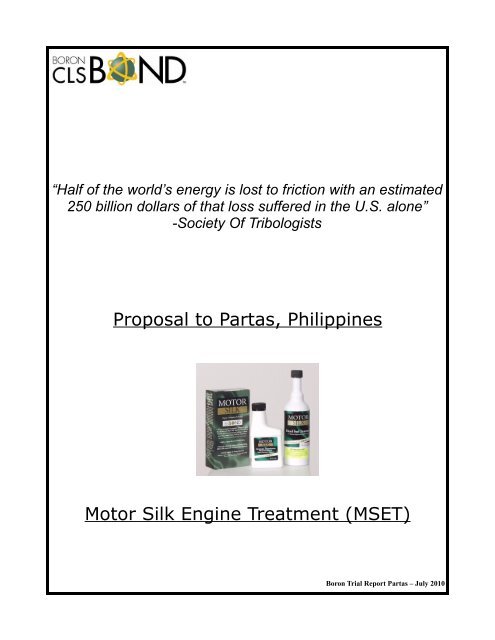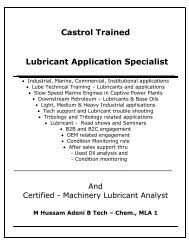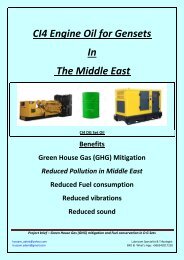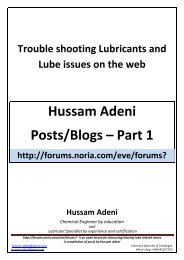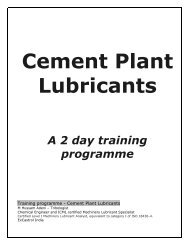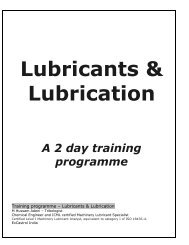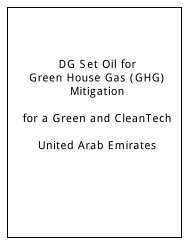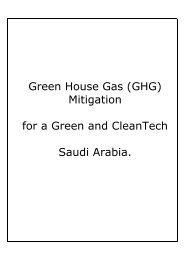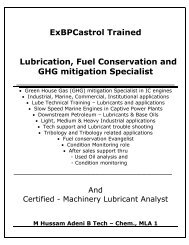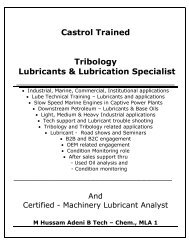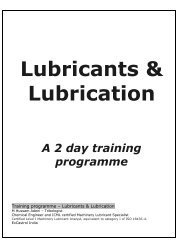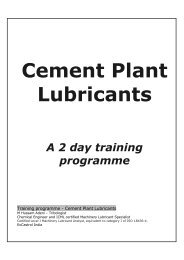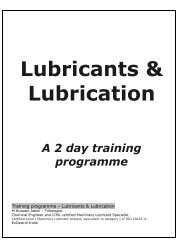Performance Report MAN & Nissan Engines
Fuel conservation with Boron CLS Bond additive after treatment on MAN and Nissan Engines with Public Transport company in Manila, Philippines
Fuel conservation with Boron CLS Bond additive after treatment on MAN and Nissan Engines with Public Transport company in Manila, Philippines
Create successful ePaper yourself
Turn your PDF publications into a flip-book with our unique Google optimized e-Paper software.
“Half of the world’s energy is lost to friction with an estimated<br />
250 billion dollars of that loss suffered in the U.S. alone”<br />
-Society Of Tribologists<br />
Proposal to Partas, Philippines<br />
Motor Silk Engine Treatment (MSET)<br />
Boron Trial <strong>Report</strong> Partas – July 2010
How Boron CLS Technology works<br />
Fuel economy: Engine treatment<br />
The energy diagram above shows, that only 12.6 % of the energy, is used to actually move the<br />
vehicle, in typical city driving conditions. A very large slice, almost 2/3 rd is lost due to engine<br />
friction. Boron CLS Bond Technology addresses this and employs nano technology in its<br />
deployment in triboapplications that dramatically reduces friction. The super lubricity of the<br />
Boron CLS Bond technology offers the following benefits:<br />
Fuel economy: Fuel additive<br />
• Reduces friction up to 80%<br />
• Reduces friction heat 40 – 50%<br />
• Reduces wear up to 90%<br />
• Reduces maintenance costs up to 50%<br />
• Reduces emissions<br />
• Increases engine efficiency 5 – 7%<br />
• Increases fuel efficiency up to 20%<br />
• Rebuild cycles extended 2 – 3 times<br />
• Extend oil drain cycle 2+ times.<br />
Popular fuel additives today, are largely detergents of various types, which provide improved<br />
fuel economy by keeping injectors clean. Boron CLS Bond goes beyond being a mere detergent,<br />
its solvency prevents buildup of varnish and other fuel and combustion deposits. The wear<br />
protection ensures extension of life of pumps, injectors and valves. Finally, the reduction of<br />
emissions means a greener, cleaner environment. Additionally, as the products are ISO 14064<br />
compliant, documenting and registering the reduction in emissions, can result in accruing of<br />
tradeable “Carbon Credits.”<br />
Boron Trial <strong>Report</strong> Partas – July 2010
A brief summary of product benefits and deliverables for CLS Bond Technology<br />
Prior to conducting meaningful trials we need a quick look at the expectations from the trials<br />
and these can be summarized by the following:<br />
1. Reduction of emissions.<br />
• Measurable - at emission center's – Opacity for Diesel <strong>Engines</strong><br />
Suggest we conduct emission test before and immediately after MSET treatment.<br />
Implication: Bulk of the emissions is unborn components of combustion. Reduced emissions indicate a<br />
more complete combustion and this would generate more power and will manifest itself in improved fuel<br />
economy.<br />
2. Fuel economy<br />
• Measurable - by compression tests on cylinders.<br />
Suggest we conduct compression tests before and within 2 hrs of Boron MSET treatment.<br />
Implication: CLS Bond Technology employs nano technology to fill up asperities on the metallic surface<br />
and this ensures complete sealing, thus improving engine efficiency. As a direct result of complete sealing,<br />
there is more power available and reflects in improved fuel economy.<br />
3. Extension of oil life<br />
• Measurable - by collecting used oil samples for analysis – over a 2 to 6 month<br />
period.<br />
Suggest we collect samples of used oil. First sample – sample of oil collected at, last oil change.<br />
Thereafter, collect samples at intervals of 1500 km, 3000 km, 4500 km (or 100 hrs, 150 hrs, 200 hrs, 250<br />
hrs in the case of Gen sets).<br />
Track movement of properties of oil for changes in Kin. Vis. @40, Kin. Vis. @100, Flash Point, TBN, TAN,<br />
Water (moisture).<br />
Implication: Oxidation is a direct result of heat and pressure typical in any engine and all oils oxidize in<br />
use. The presence of water/moisture fuels acidity and thereby corrosion of vital components in the engine.<br />
CLS Bond technology reduces friction and frictional heat thereby retards oxidation. CLS Bond technology<br />
also utilizes moisture, available during the combustion process, to replenish itself. Separately, it boosts<br />
TBN and cushions TAN. As a direct result of this oil life can be extended, by as much as twice or more,<br />
when monitored employing Oil condition monitoring practice. This means savings in oil costs.<br />
4. Engine longevity<br />
• Measurable - by collecting used oil samples for analysis – over a 2 to 6 month<br />
period. Benchmark sample would be the sample collected from the oil last drained.<br />
Suggest we collect samples of used oil. First sample (Benchmark sample) – sample of oil collected at last<br />
oil change. Thereafter, collect samples at intervals of 1500 km, 3000 km, 4500 km (or 100 hrs, 150 hrs,<br />
200 hrs, 250 hrs in the case of Gen sets).<br />
Track movement of engine wear for metal particles, Fe, Al, Cu, Pb. Cr., and Pentane Insolubles.<br />
Implication: Like oxidation, wear is normal in any engine. The metallic component in an engine is largely<br />
made up of Iron (Fe), Aluminum, Copper, Chromium etc.. The engine oil, while circulating round the<br />
engine, clears the metallic debris (metallic fines) from the point of wear. A wear metal analysis (of samples<br />
collected from time to time) detects these, which are normally in a few parts per million (PPM). When this<br />
data is plotted, a trend emerges, and sudden increase in buildup of different metallic debris would indicate<br />
probable wear. Machine failure can be predicted by using this Preventive maintenance practice. The super<br />
lubricity generated by CLS Bond technology ensures reduction of wear by as much as 90% and reduction<br />
of friction by 80% and frictional heat by 40 to 50%. This would indicate longevity of engine, extend engine<br />
overhaul / rebuild times 2 to 3 times, reduce downtime and cut maintenance costs drastically. Additionally,<br />
the engine would be smoother, with lower vibrations and lesser sound.<br />
Boron Trial <strong>Report</strong> Partas – July 2010
Trials – Boron Engine Treatment for Partas Buses<br />
Objective:<br />
• Reduction of emissions with use of Boron CLS Bond Technology (Boron<br />
Engine treatment – MSET).<br />
• Secondly, Improvement of engine efficiency, thereby improved Fuel<br />
economy after Boron Treatment.<br />
• Based on data generated during trials illustrate potential for savings to<br />
Partas by use of Boron CLS Bond Motor Silk Engine Treatment (MSET)<br />
Trial - Plans<br />
Boron Treatment to be conducted on 4 buses as follows:<br />
1. <strong>MAN</strong> – 18 – 310 Bus – Air-conditioned – 2 Nos<br />
2. <strong>Nissan</strong> Diesel PE 6T – Airconditioned - 2 Nos<br />
Vehicle owner and contact for trials<br />
Partas Transportation Company Inc.. Paseo de Blas, Valenzuela, Metro Manila.<br />
Contact: Joal D Labao, V P - Maintenance<br />
Trial data:<br />
1. a. Bus - <strong>MAN</strong> 18-310 – Air-conditioned<br />
◦ Plate No: TVZ 711<br />
◦ Bus reference Partas:81228<br />
◦ Date : 10 th October 2009<br />
◦ Oil sump : 32 Lt<br />
◦ Oil: Shell Rimula Super 15w-40 – Oil change at 15,000 km.<br />
◦ Oil change: Yes – approx 15000 km – sample collected<br />
◦ Oil filter: Engine Oil filter changed – 1 Nos.<br />
◦ Secondary Oil Filter – changed – 2 Nos<br />
◦ Boron treatment: MSET – Engine Treatment<br />
▪ MSET – 10% of 32 Lt sump : 3.2 Lt<br />
▪ Engine Oil – Shell Rimula Super 15w-40 – 28.8 Lt<br />
1. b. Bus - <strong>MAN</strong> 18-310 – Air-conditioned –<br />
◦ Plate No: TWG 743<br />
◦ Bus reference Partas:81318<br />
◦ Date : 10 th October 2009<br />
◦ Oil sump : 32 Lt<br />
◦ Oil: Shell Rimula Super 15w-40 – Oil change at 15,000 km.<br />
◦ Oil change: Yes – approx 15000 km – sample collected<br />
◦ Oil filter: Engine Oil filter changed – 1 Nos.<br />
◦ Secondary Oil Filter – changed – 2 Nos<br />
◦ Boron treatment: MSET – Engine Treatment<br />
▪ MSET – 10% of 32 Lt sump : 3.2 Lt<br />
▪ Engine Oil – Shell Rimula Super 15w-40 – 28.8 Lt<br />
Boron Trial <strong>Report</strong> Partas – July 2010
2 a. Bus <strong>Nissan</strong> Diesel – PE 6T Air-conditioned<br />
◦ Plate No: PVR 248<br />
◦ Bus reference Partas:8738<br />
◦ Date : 10 th October 2009<br />
◦ Oil sump : 26 Lt<br />
◦ Oil: Shell Rimula Super 15w-40 – Oil change at 15,000 km.<br />
◦ Oil change: Yes – approx 15000 km – sample collected<br />
◦ Oil filter: Engine Oil filter changed – 1 Nos.<br />
◦ Secondary Oil Filter – changed – 2 Nos<br />
◦ Boron treatment: MSET – Engine Treatment<br />
▪ MSET – 10% of 28 Lt sump : 2.8 Lt<br />
▪ Engine Oil – Shell Rimula Super 15w-40 – 25.2 Lt<br />
2. b. Bus <strong>Nissan</strong> Diesel – PE 6T Air-conditioned<br />
◦ Plate No: PXH 587<br />
◦ Bus reference Partas:8928<br />
◦ Date : 10 th October 2009<br />
◦ Oil sump : 26 Lt<br />
◦ Oil: Shell Rimula Super 15w-40 – Oil change at 15,000 km.<br />
◦ Oil change: Yes – approx 15000 km – sample collected<br />
◦ Oil filter: Engine Oil filter changed – 1 Nos.<br />
◦ Secondary Oil Filter – changed – 2 Nos<br />
◦ Boron treatment: MSET – Engine Treatment<br />
▪ MSET – 10% of 28 Lt sump : 2.8 Lt<br />
▪ Engine Oil – Shell Rimula Super 15w-40 – 25.2 Lt<br />
Emission check:<br />
An emission check - Smoke Opacity was carried out on all four buses prior to Boron<br />
treatment. Emission checks were carried out again after Boron treatment on all four buses.<br />
Emission protocol:<br />
An average of 5 values were considered. The average values were tabulated.<br />
Engine treatment:<br />
On 10th Oct 2009, Boron CLS Bond product, Motor Silk Engine Treatment (MSET) was<br />
added at a ratio of 10% of Engine Oil sump of 32.0 Lt (<strong>MAN</strong>) and 28.0 Lt (<strong>Nissan</strong> Diesel).<br />
The engine was run on idle for 45 mins, to enable the Boron CLS Bond Technology to form<br />
on the cylinder walls.<br />
Boron Trial <strong>Report</strong> Partas – July 2010
To test the efficacy of the treatment an emission check was carried out again after the<br />
Boron Motor Silk Engine Treatment (MSET). The emission data collated is tabulated below:<br />
The emissions values are tabulated below:<br />
Date Vehicle Plate number Opacity Emission Test -Average value<br />
<strong>MAN</strong> – 18-310 Bus<br />
10th Oct 09 <strong>MAN</strong> 18-310 TVZ 711 0.51 k – Before MSET treatment<br />
10th Oct 09 <strong>MAN</strong> 18-310 TVZ 711 0.10 k – After MSET treatment<br />
Reduction in Emission as a result of MSET<br />
treatment<br />
80% reduction of emissions<br />
10th Oct 09 <strong>MAN</strong> 18-310 TWG 743 0.05 k – Before MSET treatment<br />
10th Oct 09 <strong>MAN</strong> 18-310 TWG 743 0.02 k – After MSET treatment<br />
Reduction in Emission as a result of MSET<br />
treatment<br />
<strong>Nissan</strong> Diesel<br />
60% reduction of emissions<br />
10th Oct 09 <strong>Nissan</strong> Diesel PVR 248 2.09 k – Before MSET treatment<br />
10th Oct 09 <strong>Nissan</strong> Diesel PVR 248 0.57 k – After MSET treatment<br />
Reduction in Emission as a result of MSET<br />
treatment<br />
72% reduction of emissions<br />
10th Oct 09 <strong>Nissan</strong> Diesel PXH 587 0.74 k – Before MSET treatment<br />
10th Oct 09 <strong>Nissan</strong> Diesel PXH 587 0.27 k – After MSET treatment<br />
Reduction in Emission as a result of MSET<br />
treatment<br />
64% reduction of emissions<br />
Conclusion: Emission Tests<br />
The Boron MSET treatment reduced the emissions between 60 to 80%<br />
Engine efficiency:<br />
1. By - Cylinder compression Tests<br />
2. By – Improved fuel economy<br />
Boron Trial <strong>Report</strong> Partas – July 2010
1. Cylinder compression Test results: - <strong>Nissan</strong> Diesel<br />
Sl No Bus Nos. Plate Nos Engine<br />
2a 8738 PVR 248 <strong>Nissan</strong> Diesel - PE 6T<br />
RPM<br />
Compression Pressure (PSI)<br />
P1 P2 P3 P4 P5 P6<br />
Before 500 430 420 430 425 430 430<br />
After<br />
Boron<br />
500 430 430 430 430 430 430<br />
Before 1500 440 430 440 425 450 460<br />
After<br />
Boron<br />
1500 450 450 450 450 460 460<br />
After Boron MSET treatment compression pressure balanced in all cylinders.<br />
2b 8928 PXH 587 <strong>Nissan</strong> Diesel - PE 6T<br />
RPM<br />
Compression Pressure (PSI)<br />
P1 P2 P3 P4 P5 P6<br />
Before 500 430 430 430 480 430 430<br />
After<br />
Boron<br />
500 430 430 430 430 430 430<br />
Before 1500 480 480 480 480 480 480<br />
After<br />
Boron<br />
1500 480 480 480 480 480 480<br />
After Boron MSET treatment compression pressure balanced in all cylinders.<br />
Compression data: <strong>MAN</strong> 18-310: <strong>MAN</strong> buses under service contract with <strong>MAN</strong> and<br />
compression data was not furnished.<br />
Conclusions: Cylinder compression pressures<br />
Effective engine treatment with Boron shows up, in the balancing up, of the cylinder<br />
compression pressures. Idling performance will be smoother as a result of almost equal<br />
compression pressures in all cylinders.<br />
2. Fuel consumption:<br />
Sl No<br />
Bus<br />
Nos.<br />
Plate Nos Engine Fuel consumption<br />
– before & after Boron treatment<br />
1a 81228 TVZ 711 <strong>MAN</strong> 18-310 2.74 km/Lt<br />
TVZ 711 <strong>MAN</strong> 18-310 2.78 km/Lt<br />
After Boron treatment Improvement of 14.60%<br />
1b 81318 TWG 743 <strong>MAN</strong> 18-310 2.27 km/Lt<br />
TWG 743 <strong>MAN</strong> 18-310 2.63 km/Lt<br />
Boron Trial <strong>Report</strong> Partas – July 2010
After Boron treatment Improvement of 15.90%<br />
2a 8738 PVR 248 PE 6T 2.66 km/Lt<br />
PVR 248 PE 6T 2.91 km/Lt<br />
After Boron treatment Improvement of 9.40%<br />
2b 8928 PXH 587 PE 6T 2.21 km/Lt<br />
PXH 587 PE 6T 2.65 km/Lt<br />
After Boron treatment Improvement of 19.90%<br />
Conclusions: improvement in fuel economy<br />
The efficacy of the Boron MSET treatment is demonstrated in improved Fuel economy. As the<br />
rated power, is now fully available, it will reflect in a quicker response during acceleration.<br />
Further, improvement in rings sealing capacity eliminates blow-by gases and results in improved<br />
fuel economy. This averages 14.9% in the two types of Buses on which trials were conducted.<br />
Costing for Partas<br />
Phase I – MSET –<br />
Engine Treatment<br />
Fleet details<br />
Vehicle<br />
Engine<br />
Oil<br />
Sump in<br />
Lt.<br />
Vehicle<br />
Numbers<br />
Partas, Manila,<br />
Philippines<br />
Boron Reqd<br />
- Lt –<br />
1 dosage<br />
/Year or<br />
170,000 km<br />
Hino RM 2 B<br />
300 HP 30 35 105.00<br />
<strong>Nissan</strong> PE 6T & PF<br />
6T 290 HP 28 62 173.60<br />
Fuso 8DC 9<br />
315 HP 28 12 33.60<br />
Yuchai DGAU<br />
270 & 290 HP 26 45 117.00<br />
Mercedes Benz<br />
17.250 250 HP 29 12 34.80<br />
Hyundai Universe<br />
300 HP 28 2 5.60<br />
<strong>MAN</strong> 18-310 16-<br />
290 310/290 HP 32 51 163.20<br />
Assumption – Running Km/Year<br />
of vehicles in km<br />
Bus running/year<br />
for 1 dosage MSET 170000<br />
485 km/day, 350<br />
working days =<br />
170,000 170000<br />
Costs in<br />
USD<br />
Cost in Peso<br />
Dec 1 st 2009<br />
USD=47.005<br />
PHP<br />
219 632.80 32,577.62 1,531,311<br />
The requirement is 633 Lt, which works out to 3 barrels plus a 20 Lt<br />
pail. ( Four buses have already been treated. Hence quantity<br />
required is 626 Lt. The 4 buses treated 2 <strong>Nissan</strong> = 5.6 Lt and the<br />
two <strong>MAN</strong> = 6.4 Lt a total of 12 Lt.)<br />
Boron Trial <strong>Report</strong> Partas – July 2010
Prices in packing<br />
available – barrels,<br />
pail, can<br />
MSET–Engine<br />
Price in<br />
USD<br />
Cost/Lt in<br />
USD<br />
Total cost in<br />
USD Qty Cost in PHP<br />
Treatment–202 Lt brl 10495.50 51.95 31,486.50 606 Lt<br />
MSET – Engine<br />
Treatment – 20 Lt pail 1091.12 54.55 1,091.12 20 Lt<br />
32,577.62 626 Lt<br />
Assumption: 219<br />
buses @2.2 km/Lt works<br />
out to 170,000 km/Yr (@<br />
485 km/day, 350 days/yr<br />
= 169,995 km/Yr)<br />
Monthly<br />
reqd in<br />
Lt<br />
Annual<br />
reqd in Lt<br />
Diesel cost<br />
in PHP/Lt<br />
1,531,311<br />
Diesel cost in<br />
PHP<br />
Diesel costs @ PHP<br />
32.30/Lt 1,409,605 16,915,261 32.300 546,362,942<br />
1 dosage -> 32.391 547,894,253<br />
Budgeted costs<br />
with Boron<br />
Treatment<br />
Running<br />
km/year<br />
MSET<br />
Dosage/<br />
year<br />
Cost increase due to<br />
Boron – per Lt 170000 One PHP 0.091 Lt<br />
Cost increase due to<br />
Boron – in % 170000 One 0.280 %<br />
Projection with 19.9% reduction (Annual requirement 16.9 million Lt of<br />
Diesel) – One dosage/Year<br />
Projected savings at<br />
19.9% -Diesel in PHP<br />
Savings /<br />
day 298,715<br />
Savings /<br />
year PHP 109,030,956<br />
Hence 19.9% reduced<br />
consumption in Lt Lt. 13,549,124<br />
Projected savings @<br />
19.9% -Diesel PHP /Lt PHP 6.446<br />
Hence revised costs of<br />
Diesel in PHP PHP 25.945<br />
ROI of<br />
153,311 PHP 298,715<br />
PHP<br />
saving Or an ROI 5.13 days<br />
Projection with 15.9% reduction (Annual requirement<br />
16.9 million Lt of Diesel) – One dosage/Year<br />
Projected savings at<br />
15.9% -Diesel in PHP<br />
Savings/<br />
day 238,672 Savings /year PHP 87,115,186<br />
Hence 15.9% reduced<br />
consumption in Lt Lt. 14,225,735<br />
Projected savings at<br />
15.9% -Diesel-PHP/Lt PHP 5.150<br />
Hence revised costs of<br />
Diesel in PHP PHP 27.240<br />
ROI of<br />
PHP<br />
238,672<br />
153,311 PHP<br />
saving<br />
Or an ROI 6.42 days<br />
Projection with 14.6% reduction (Annual requirement 16.9<br />
million Lt of Diesel) – One dosage Year<br />
Projected savings at<br />
14.6% -Diesel in PHP<br />
Savings/<br />
day 219,158 Savings/year PHP 79,992,561<br />
Hence 14.6% reduced<br />
consumption in Lt Lt. 14,445,633<br />
Boron Trial <strong>Report</strong> Partas – July 2010
Projected savings at<br />
14.6% -Diesel-PHP/Lt PHP 4.729<br />
Hence revised costs of<br />
Diesel in PHP PHP 27.662<br />
ROI of<br />
153,311 PHP 219,158<br />
PHP<br />
saving Or an ROI 6.99 days<br />
Projection with 9.4% reduction (Annual requirement 16.9<br />
million Lt of Diesel) – One dosage/Year<br />
Projected savings at<br />
9.4% -Diesel in PHP<br />
Savings/<br />
day 141,102<br />
Savings/yea<br />
r PHP 51,502,060<br />
Hence 9.4% reduced<br />
consumption in Lt Lt. 15,325,227<br />
Projected savings at<br />
9.4% -Diesel - PHP/Lt PHP 3.045<br />
Hence revised costs of<br />
Diesel in PHP PHP 29.346<br />
ROI of<br />
153,311 PHP<br />
141,102<br />
PHP<br />
saving<br />
Or an ROI 10.85 days<br />
Implications of an average 14.9% improvement in Fuel economy and potential for<br />
savings at Partas<br />
The improvement in Fuel economy ranges from 9.4 to 19.9 %, with Boron Engine<br />
Treatment that increases the fuel costs a mere 0.091 Peso or 0.271%.<br />
The Partas passenger transportation service runs mixed Fleet of 219 buses operating<br />
approx. 150,000 to 170,000 km each per year at an average fuel consumption of 2.2<br />
km/Lt.<br />
By the use of Boron CLS Bond Motor Silk Engine Treatment (MSET) Partas can save millions<br />
of PHP and reduce Diesel off take by more than a million Lt:<br />
• ROI between 5.13 to 10.85 days for a Boron MSET investment of 1.53<br />
million PHP.<br />
• Save between 51.5 million to 109 million Peso each year.<br />
• Save between 1.59 million to 3.367 million Lt of Diesel each year<br />
Boron Trial <strong>Report</strong> Partas – July 2010
Oil Analysis report – Used oil collected prior to Boron treatment<br />
Vehicle data Plate No Owner Year<br />
Registration No/ Owner PVR 248<br />
Make / model /Year <strong>Nissan</strong> Diesel<br />
Engine details 290 HP PE 6T<br />
Fuel Tank capacity<br />
Lt<br />
Crank case or Engine Oil sump capacity 28 Lt<br />
Transmission or Gear Oil sump capacity 16 Lt<br />
Devices/gadgets: Twin filteration lube oil system installed.<br />
Engine Treatment-MSET dosage 1:10 = 2.80 Lt<br />
Lubricant - Engine Oil in use Shell Rimula X 15w/40<br />
Servicing Data - ( Last servicing )<br />
Last servicing - kms<br />
Oil change Yes; Oil filter change Yes
Vehicle data Plate No Owner Year<br />
Registration No/ Owner PXH 587 Partas<br />
Transportation<br />
Make / model /Year<br />
<strong>Nissan</strong> Diesel<br />
Company, Inc.<br />
Engine details 290 HP PE 6T<br />
Fuel Tank capacity<br />
Lt<br />
Crank case or Engine Oil sump capacity 28 Lt<br />
Transmission or Gear Oil sump capacity 16 Lt<br />
Devices/gadgets: Twin filteration lube oil system installed.<br />
Engine Treatment-MSET dosage 1:10 = 2.80 Lt<br />
Lubricant - Engine Oil in use Shell Rimula X 15w/40<br />
Oil sump 28 Lt. Shell Rimula X 15w/40 25.2 Lt + Boron MSET 2.8 Lt<br />
Servicing Data - ( Last servicing )<br />
Last servicing - kms<br />
Oil change Yes; Oil filter change Yes ← date<br />
Opacity Test<br />
Average of 5 values<br />
10 th Oct 2009<br />
Before Boron Treatment<br />
After Boron Treatment<br />
Visual<br />
Odometer<br />
TEST<br />
Method<br />
0.74 k<br />
0.27 k<br />
Trend analysis<br />
New<br />
Oil<br />
Clear<br />
Used<br />
Oil<br />
dark<br />
viscous<br />
Comments<br />
Colour Yellow Black<br />
Oil condition<br />
KV 40 cSt 105 102.85 2 Within acceptable limits<br />
KV 100 cSt 14.5 13.7 6 Within acceptable limits<br />
VI 139 122 12 Within acceptable limits<br />
TBN 10.8 5.67 48 Within acceptable limits<br />
TAN -- 23.46<br />
Values high, probably due<br />
to water<br />
Flash Pt. °C PMCC 205 230 -12 Within acceptable limits<br />
Water Content, %Vol Nil 0.5<br />
Fuel Content, %Vol Nil ND<br />
Pentane Insoluble,% Nil 0.16 Within acceptable limits<br />
Wear metal<br />
Iron ppm AAS NA 31.97<br />
Copper ppm AAS NA 538<br />
Chromium ppm AAS NA ND<br />
Lead ppm AAS NA 16.79<br />
Variation<br />
in %<br />
Reference: PXH 587<br />
Km -<br />
10 Oct 09<br />
Reduction of emissions<br />
after Boron treatment<br />
64%<br />
Above acceptable limits, of<br />
0.3 % by Vol.<br />
Values high,to check<br />
bearings<br />
Boron Trial <strong>Report</strong> Partas – July 2010
Vehicle data Plate No Owner Year<br />
Registration No/ Owner TVZ 711<br />
Make / model /Year <strong>MAN</strong> Diesel<br />
Engine details 310 HP 18-310<br />
Fuel Tank capacity<br />
Lt<br />
Crank case or Engine Oil sump capacity 32 Lt<br />
Transmission or Gear Oil sump capacity 18 Lt<br />
Devices/gadgets: Twin filteration lube oil system installed.<br />
Engine Treatment - MSET dosage 1: 10 = 3.2 Lt Km -<br />
10 Oct 09<br />
Lubricant - Engine Oil in use Shell Rimula X 15w/40<br />
Oil sump 32 Lt. Shell Rimula X 15w/40 28.8 Lt + Boron MSET 3.2 Lt<br />
Servicing Data - ( Last servicing )<br />
Last servicing - kms<br />
Oil change Yes; Oil filter change Yes ← date<br />
Opacity Test<br />
10 th Oct 2009<br />
Average of 5 values<br />
Before Boron Treatment<br />
After Boron Treatment<br />
Visual<br />
Odometer<br />
TEST<br />
Method<br />
Clear<br />
0.51 k<br />
0.10 k<br />
Trend analysis<br />
New Used Variation<br />
Oil Oil in %<br />
dark<br />
viscous<br />
Reference: TVZ 711<br />
Partas<br />
Transportation<br />
Company, Inc.<br />
Reduction of emissions<br />
after Boron treatment<br />
80%<br />
3 rd<br />
sample<br />
Colour Yellow Black<br />
Oil condition<br />
KV 40 cSt 105 110.5 -5 Within acceptable limits<br />
KV 100 cSt 14.5 14.45 0 Within acceptable limits<br />
VI 139 123 12 Within acceptable limits<br />
TBN 10.8 6.11 43 Within acceptable limits<br />
TAN -- 33.45<br />
Flash Pt. °C PMCC 205 238 -16 Within acceptable limits<br />
Water Content,% Vol Nil 0.03 Within acceptable limits<br />
Fuel Content, % Vol Nil ND<br />
Pentane Insoluble,% Nil 0.12 Within acceptable limits<br />
Wear metal<br />
Iron ppm AAS NA 13.81<br />
Copper ppm AAS NA ND<br />
Chromium ppm AAS NA ND<br />
Lead ppm AAS NA 9.74<br />
Boron Trial <strong>Report</strong> Partas – July 2010
Reference: TWG 743<br />
Vehicle data Plate No Owner Year<br />
Registration No/ Owner TWG 743 Partas<br />
Transportation<br />
Make / model /Year <strong>MAN</strong> Diesel<br />
Company, Inc.<br />
Engine details 310 HP 18-310<br />
Fuel Tank capacity<br />
Lt<br />
Crank case or Engine Oil sump capacity 32 Lt<br />
Transmission or Gear Oil sump capacity 18 Lt<br />
Devices/gadgets: Twin filteration lube oil system installed.<br />
Engine Treatment -MSET dosage 1: 10 = 3.2 Lt<br />
Km -<br />
10 Oct 09<br />
Lubricant - Engine Oil in use Shell Rimula X 15w/40<br />
Oil sump 32 Lt. Shell Rimula X 15w/40 28.8 Lt + Boron MSET 3.2 Lt<br />
Servicing Data - ( Last servicing )<br />
Last servicing - kms<br />
Oil change Yes; Oil filter change Yes ← date<br />
Opacity Test<br />
Average of 5 values<br />
10 th Oct 2009<br />
Before Boron Treatment<br />
After Boron Treatment<br />
Visual<br />
Odometer<br />
TEST<br />
Method<br />
0.05 k<br />
0.02 k<br />
Trend analysis<br />
New Used Variation<br />
Oil Oil in %<br />
Clear<br />
dark<br />
viscous<br />
Comments<br />
Colour Yellow Black<br />
Oil condition<br />
KV 40 cSt 105 91.52 13 Within acceptable limits<br />
KV 100 cSt 14.5 7.11 51 Within acceptable limits<br />
VI 139 134 4 Within acceptable limits<br />
TBN 10.8 12.05 -12<br />
Reduction of emissions<br />
after Boron treatment<br />
60%<br />
Odd value. Increased<br />
rather than decreased<br />
TAN -- 33.45<br />
Flash Pt. °C PMCC 205 228 -11 Within acceptable limits<br />
Water Content,% Vol Nil 0.06 Within acceptable limits<br />
Fuel Content, % Vol Nil ND<br />
Pentane Insoluble,% Nil 0.09 Within acceptable limits<br />
Wear metal<br />
Iron ppm AAS NA 29.49<br />
Copper ppm AAS NA 9.96<br />
Chromium ppm AAS NA ND<br />
Lead ppm AAS NA 17.93<br />
Boron Trial <strong>Report</strong> Partas – July 2010
Remarks & conclusion on Oil analysis:<br />
The thumb rule for discarding oils (condemning limits) based on physical parameters for use in extreme<br />
conditions such as marine/ship applications are as follows:<br />
• Viscosity: Max 25% increase or 20% decrease in KV 100 compared to fresh oil.<br />
• Viscosity: Max 45% increase or 25% decrease in KV 40 compared to fresh oil.<br />
• TBN: Total Base Number Max 50% depletion compared to fresh oil TBN.<br />
• Water: Max 0.3 vol %.<br />
• Insoluble: Max 2. w%<br />
• Flash Point: Min 170 Deg C ( PMCC) or Min 190 deg C (COC)<br />
Values physiochemical properties, of the sample of used oil, analyzed were within the acceptable limits,<br />
indicated above, and suitable for further use, if desired.<br />
Boron Trial <strong>Report</strong> Partas – July 2010


